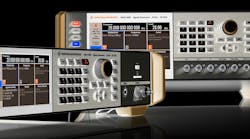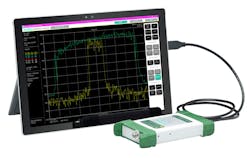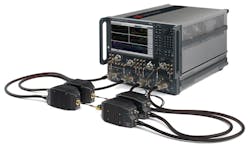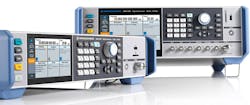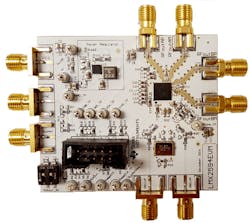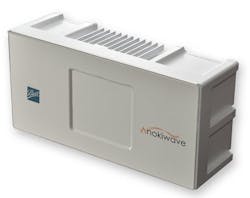Download this article as a .PDF
In 2017, many companies in the RF/microwave industry introduced new products that propelled them to greater heights. To meet the needs of today’s commercial, military, and industrial markets, companies are setting the bar higher in terms of product performance. Here, Microwaves & RF presents our picks for the top products of2017.
Test & Measurement Solutions
No question, suppliers of test-and-measurement equipment delivered a number of cutting-edge products in 2017. In a sense, one could say that some of the newest high-frequency test-and-measurement equipment is changing the perception of traditional test instrumentation. For example, instruments such as spectrum analyzers and vector network analyzers (VNAs) have traditionally been built in the form of bulky boxes. However, some suppliers are now offering smaller, portable versions.
One product line that was launched in 2017 that exemplifies the trend of smaller test instruments is Anritsu’s Spectrum Master MS2760A (Fig. 1). This line of portable spectrum analyzers consists of six different models, with the highest-frequency version covering frequencies as high as 110 GHz. At 110 GHz, greater than 100 dB of dynamic range is achieved. Furthermore, the MS2760A spectrum analyzers measure only 6.1 × 3.3 × 1.1 in. (155 × 84 × 27 mm) and weigh just 9 oz. (255 g).
1. The Spectrum Master MS2760A portable spectrum analyzers are USB-powered and offer performance to 110 GHz.
Another company known for smaller test instruments is Copper Mountain Technologies. In 2017, the company added to its selection of VNAs by introducing the R180 1-port VNA. The R180 1-port VNA covers a frequency range of 1 MHz to 18 GHz. It offers the benefit of being able to directly connect to a device-under-test (DUT), thereby eliminating the need for test cables. The R180 is well suited for cable testing, antenna testing, and more.
Speaking of VNAs, one established company actually made its debut in the VNA arena in 2017. That company is Tektronix, which introduced the TTR500 Series this year (Fig. 2). This series of USB-based VNAs consists of two models: the TTR503A and the TTR506A. The TTR503A covers a frequency range of 100 KHz to 3 GHz, while the TTR506A covers a frequency range of 100 kHz to 6 GHz. The TTR500 VNAs achieve greater than 122 dB of dynamic range. Furthermore, they measure just 11.25 × 8.125 × 1.75 in. (285.8 × 206.4 × 44.5 mm) and weigh only 3.5 lb. (1.59 kg).
2. The TTR500 VNAs achieve a dynamic range greater than 122 dB.
Not to be outdone, Keysight Technologies unveiled its new VNA test system to meet the growing need for millimeter-wave testing. The N5290A and N5291A millimeter-wave systems allow for testing at frequencies over 100 GHz (Fig. 3). The N5290A/N5291A test solutions consist of an advanced VNA, a test-set controller, and compact frequency extenders.
3. This broadband millimeter-wave network analyzer solution includes an advanced VNA, a test-set controller, and compact frequency extenders.
While the products mentioned are on the analysis side, some notable products were introduced in 2017 on the signal-generation side as well. For example, Tektronix made headlines in more ways than one in 2017, as the company also introduced the AWG5200 Series of arbitrary wave generators (Fig. 4). These AWGs can achieve sample rates as high as 5 GSamples/s (and as high as 10 GSamples/s with 2× interpolation). Textronix offers two-, four-, and eight-channel models.
4. An AWG5200 Series AWG can have as many as eight independent waveform generation channels.
Also making this list are the R&S SMA100B signal generators from Rohde & Schwarz (Fig. 5). Four models are available, offering performance to 3.0, 6.0, 12.75, and 20.0 GHz, respectively. For a 1-GHz signal, phase noise is -152 dBc/Hz at 20-kHz offset. For a 10-GHz signal, phase noise is -132 dBc/Hz at 20-kHz offset. The R&S SMA100B signal generators also deliver high output power, as the 6-GHz model can provide signals with a power level as high as +38 dBm.
5. The R&S SMA100B signal generators are available in four frequency ranges, with the highest-frequency model covering 8 kHz to 20 GHz.
A couple more test-and-measurement products are worthy of recognition. One is the PXIe-5820 baseband vector signal transceiver (VST) from National Instruments (NI). The PXIe-5820, which follows last year’s PXIe-5840 RF VST, is well suited to meet the needs of next-generation wireless communications, such as 5G and IEEE 802.11ax. The PXIe-5820 can achieve 1 GHz of in-phase/quadrature (I/Q) instantaneous bandwidth for generation and analysis.
Last but not least, Focus Microwaves unveiled its MPT-110200 tuner system. This system provides impedance tuning functionality via three independently controlled tuning probes. The system covers a frequency range of 20 to 110 GHz.
Components and More
Test-and-measurement companies weren’t the only ones that demonstrated innovation in 2017, as several components suppliers introduced some impressive products as well. For instance, Analog Devices introduced the AD9375 RF transceiver, which followed the release of last year’s AD9371. The AD9375 covers a frequency range of 300 MHz to 6 GHz. It integrates a digital pre-distortion (DPD) solution, multiple receivers and transmitters, and on-board frequency synthesizers.
Another notable product from 2017 is Texas Instruments’ LMX2594 wideband synthesizer, which can generate any frequency from 10 MHz to 15 GHz (Fig. 6). The phase detector frequency can be as high as 400 MHz in integer mode and as high as 300 MHz in fractional mode. The LMX2594 is also equipped with phase synchronization capability.
6. The LMX2594 (shown on an evaluation board) is supplied in a 40-pin VQFN package that measures only 6.0 × 6.0 mm.
Continuing the theme of frequency synthesis, the Luxyn frequency synthesizers from Micro Lambda Wireless were introduced at this year’s International Microwave Symposium (IMS). The Luxyn frequency synthesizers cover a frequency range of 50 MHz to 21 GHz, with frequency steps as small as 0.001 Hz. For a 5-GHz carrier, the typical phase noise is -131 dBc/Hz at 10-kHz offset. For a 10-GHz carrier, typical phase noise is -125 dBc/Hz at 10-kHz offset. In addition, these synthesizers are built in a package that is only 4.0 × 3.6 × 0.9 in. and weighs just 15 oz.
Another product unveiled this year is one that is intended to improve driver navigation. That would be Broadcom Limited’s BCM47755 single-chip, dual-frequency global navigation satellite system (GNSS) receiver. According to the company, the BCM47755 is the first mass-market, dual- frequency GNSS receiver device. While traditional GNSS receivers have only used the L1 signal, the BCM47755 actually uses both L1 and L5 signals. The end result is 30-cm accuracy that essentially allows “lane-level” accuracy to be achieved on highways.
7. The AWA-0134 was developed using planar antenna technology.
5G millimeter-wave systems are something we can expect to hear more of in the very near future. One company that is making headlines in this realm is Anokiwave. In 2017, the company introduced the AWA-0134, which is a 256-element reconfigurable active antenna kit for 5G applications that was developed with Ball Aerospace (Fig. 7). The AWA-0134, which is driven by Anokiwave’s AWMF-0108 5G quad-core integrated circuit (IC), covers a frequency range of 26.5 to 29.5 GHz. The AWA-0134 can be used as a single 256-element array or as a 4 × 64 multiple-input multiple-output (MIMO) system.
